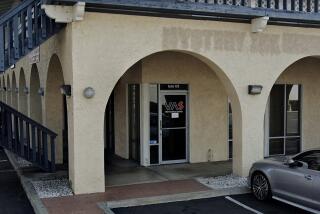Vietnam War Foes Now Fight a Common Enemy
They were enemies on Vietnam’s battlefields, but the two Vietnamese nationals and some American veterans have something in common: They suffer from illnesses they say were caused by Agent Orange.
Dang Hong Nhut and Ho Sy Hai are bringing their stories to the American public in an 11-city tour. They hope to garner support for their efforts to seek compensation from the U.S. government and the chemical companies that produced the herbicide.
“American veterans got compensation, I am hopeful that we’ll be treated equally,” Dang, 68, said in an interview in Manhattan.
David Cline, 58, of Jersey City, a Vietnam veteran who is president of Veterans for Peace, believes the Vietnamese should receive compensation. “We see this as a humanitarian and a moral issue,” he said at a meeting with the Vietnamese.
Dang, who supported the Viet Cong, is a plaintiff in a class-action suit against chemical manufacturers that was rejected in February. U.S. District Judge Jack Weinstein in Brooklyn dismissed the suit, which covered as many as 4 million alleged victims, saying the use of the herbicide during the Vietnam War did not violate international law. The Vietnamese are appealing.
During the war, about 12 million gallons of the defoliant were sprayed over South Vietnam. Agent Orange was intended to kill plants and strip leaves from trees in an effort to deprive the enemy of cover.
Ned Foote, president of the Vietnam Veterans of America’s New York chapter, said he supported the Vietnamese effort but first wanted the manufacturers to provide compensation for American soldiers still suffering, and dying, from the dioxin’s effects.
“I personally don’t hold any grudges against them,” he said. “They fought their war; we fought ours.”
In 1965, Ho, now 64, was delivering supplies to North Vietnamese troops advancing into South Vietnam. Ho remembered U.S. planes spraying herbicide along the supply route, known as the Ho Chi Minh Trail. He and fellow soldiers drank the contaminated water and bathed in it.
“We were living with the defoliant every day. We didn’t have a choice,” Ho said.
Toward the end of the war, Ho married, and he and his wife, also a soldier, wanted to start a family. Her first two pregnancies ended in miscarriages, Ho said. She then gave birth to a healthy baby boy, who became deaf and stopped talking at age 6.
In 1973 they had another boy, who was born healthy but at 8 months couldn’t hold down his food. At 3, he too became deaf, Ho said. The third child, a girl, was healthy until she turned 5, Ho said. Her glands swelled, and she died.
In 1980, the couple, who live in the northeastern province of Thai Binh, had another boy, who became mentally ill at 20.
Ho learned in 1989 that he has diabetes and prostate cancer, two diseases the U.S. Department of Veterans Affairs recognizes as linked to Agent Orange.
In May of 1965, Dang was living in Cu Chi -- a suburb of Saigon, which was renamed Ho Chi Minh City after the war -- when she witnessed American airplanes dropping the defoliant on the district, leaving behind a terrible odor and a whitish substance on the leaves.
“I thought I was going to be killed instantly or in one or two days,” recalled Dang, who still lives in Ho Chi Minh City.
For the month she lived in Cu Chi, Dang drank water from the stream and used it for cooking. She ate vegetables dusted with the dioxin, not knowing its harmful effects.
Dang said she had three miscarriages between 1973 and 1980. A fourth child was stillborn and seriously deformed, she said. In recent years, doctors have removed tumors from her intestine and thyroid.
Like Ho, Dang blames her miscarriages and health problems on Agent Orange. In 1960, before she was exposed to the dioxin, Dang gave birth to a healthy boy, now a grown man with two healthy daughters of his own.
Ho and Dang want help for future generations in Vietnam, who continue to suffer the effects of the dioxin, which remains in the soil.
“We hope to share our suffering and our pain with the American veterans. Together, we may find the quickest and the fastest solution to this problem,” Ho said. “That’s what I hope for from the trip.”
Staff writer Joseph Mallia contributed to this report.
More to Read
Sign up for Essential California
The most important California stories and recommendations in your inbox every morning.
You may occasionally receive promotional content from the Los Angeles Times.










